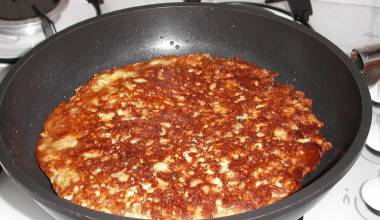Charoset

(Jewish, Israeli walnut, apple and wine Passover sweet)
Image by Wikimedia: Yoninah
Charoset (חרוסת) — also spelled haroset or haroses — is one of the symbolic foods on any Passover Seder plate. Sticky and sweet, charoset is a muddy-colored paste that is intended to resemble the mortar the Israelites used to make bricks while enslaved in Pharaoh's Egypt.
As part of the Pesach ritual, charoset is spread between two pieces of matzoh, along with some maror, or bitter herbs, and eaten as a sandwich.
Makes about 3 cups
Ingredients
- Apples, peeled, cored and finely chopped or grated -- 3
- Walnuts, toasted and chopped -- 1 cup
- Kosher sweet red wine -- 1/3 cup
- Honey -- 2 or 3 tablespoons
- Cinnamon -- 1 teaspoon
Method
- Mix all of the ingredients together in a medium bowl. Add more honey if needed to sweeten to your taste.
- Let rest for about an hour to allow the flavors mingle. Give it another good stir and serve at room temperature.
Charoset Variations
- Apples: Try a mixture of different apple varieties for the best flavor. The texture is best when they are hand chopped, but grating is a little faster.
- Walnuts: To toast walnuts, preheat your oven to 400°F. Spread the walnuts on a small baking sheet. Place the walnuts in the oven for 8 to 10 minutes. Take care that they don't burn. Remove, cool and then chop with a knife, pound in a plastic bag with a rolling pin, or pulse gently in a food processor to get your walnut pieces.
- Ashkenazi versus Sephardic Charoset: Ashkenazi Jews from Eastern Europe make a traditional charoset that uses apples, walnuts and sweet wine. Sephardic Jews will use other fruits, including dates, figs, raisins, pears and apricots, and sometimes pine nuts or almonds instead of walnuts.
- Substitute brown sugar for the honey if you like.




